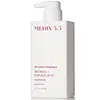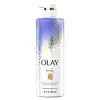What's inside
What's inside
 Key Ingredients
Key Ingredients

 Benefits
Benefits

 Concerns
Concerns

 Ingredients Side-by-side
Ingredients Side-by-side

Water
Skin ConditioningCetyl Alcohol
EmollientGlycerin
HumectantDimethicone
EmollientButyrospermum Parkii Butter
Skin ConditioningCeteareth-20
CleansingIsopropyl Myristate
EmollientFerulic Acid
AntimicrobialDipotassium Glycyrrhizate
HumectantCaprylic/Capric Triglyceride
MaskingGlyceryl Stearate
EmollientRetinol
Skin ConditioningAloe Barbadensis Leaf Juice Powder
Skin ConditioningCamellia Sinensis Leaf Extract
AntimicrobialTocopherol
AntioxidantAnthemis Nobilis Flower Extract
MaskingPyrus Malus Fruit Extract
Skin ConditioningHelianthus Annuus Extract
EmollientRosmarinus Officinalis Leaf Extract
AntimicrobialPhenoxyethanol
PreservativeCetearyl Phosphate
Skin ConditioningCarbomer
Emulsion StabilisingCaprylyl Glycol
EmollientXanthan Gum
EmulsifyingSodium Hydroxide
BufferingOryza Sativa Bran Extract
Skin ConditioningEthylhexylglycerin
Skin ConditioningSynthetic Beeswax
Emulsion StabilisingHexylene Glycol
EmulsifyingTetrasodium Glutamate Diacetate
BHT
AntioxidantWater, Cetyl Alcohol, Glycerin, Dimethicone, Butyrospermum Parkii Butter, Ceteareth-20, Isopropyl Myristate, Ferulic Acid, Dipotassium Glycyrrhizate, Caprylic/Capric Triglyceride, Glyceryl Stearate, Retinol, Aloe Barbadensis Leaf Juice Powder, Camellia Sinensis Leaf Extract, Tocopherol, Anthemis Nobilis Flower Extract, Pyrus Malus Fruit Extract, Helianthus Annuus Extract, Rosmarinus Officinalis Leaf Extract, Phenoxyethanol, Cetearyl Phosphate, Carbomer, Caprylyl Glycol, Xanthan Gum, Sodium Hydroxide, Oryza Sativa Bran Extract, Ethylhexylglycerin, Synthetic Beeswax, Hexylene Glycol, Tetrasodium Glutamate Diacetate, BHT
Water
Skin ConditioningPetrolatum
EmollientSodium Trideceth Sulfate
CleansingSodium Chloride
MaskingCocamidopropyl Betaine
CleansingTrideceth-3
EmulsifyingParfum
MaskingNiacinamide
SmoothingRetinol
Skin ConditioningRetinyl Propionate
Skin ConditioningSodium Citrate
BufferingGuar Hydroxypropyltrimonium Chloride
Skin ConditioningSodium Benzoate
MaskingXanthan Gum
EmulsifyingGlyceryl Oleate
EmollientCitric Acid
BufferingDisodium EDTA
Sodium Hydroxide
BufferingAcrylates/C10-30 Alkyl Acrylate Crosspolymer
Emulsion StabilisingMethylchloroisothiazolinone
PreservativeMethylisothiazolinone
PreservativeCI 19140
Cosmetic ColorantCI 17200
Cosmetic ColorantWater, Petrolatum, Sodium Trideceth Sulfate, Sodium Chloride, Cocamidopropyl Betaine, Trideceth-3, Parfum, Niacinamide, Retinol, Retinyl Propionate, Sodium Citrate, Guar Hydroxypropyltrimonium Chloride, Sodium Benzoate, Xanthan Gum, Glyceryl Oleate, Citric Acid, Disodium EDTA, Sodium Hydroxide, Acrylates/C10-30 Alkyl Acrylate Crosspolymer, Methylchloroisothiazolinone, Methylisothiazolinone, CI 19140, CI 17200
 Reviews
Reviews

Ingredients Explained
These ingredients are found in both products.
Ingredients higher up in an ingredient list are typically present in a larger amount.
Retinol is a gold-standard ingredient for anti-aging. It is a form of Vitamin A and belongs to the class of retinoids that also includes tretinoin.
Why is retinol famous?
It has the most scientific studies backing up its skin benefits out of all the non-prescription ingredients.
Retinol is proven to:
This is why retinol is effective at removing wrinkles, fading dark spots, treating acne, and reducing the appearance of pores.
Studies show retinol is less effective when exposed to UV. Be sure to look for appropriate packaging to keep your retinol potent (similar to Vitamin C).
Using retinol or any retinoids will increase sun-sensitivity in the first few months. Though studies show retinoids increase your skin's natural SPF with continuous use, it is best to always wear sunscreen and sun-protection.
We recommend speaking with a medical professional about using this ingredient during pregnancy.
Retinol may cause irritation in some people, so be sure to patch test. Experts recommend 'ramping up' retinol use: start using this ingredient once a week and work up to using it daily.
Read about Tretinoin
Learn more about RetinolSodium Hydroxide is also known as lye or caustic soda. It is used to adjust the pH of products; many ingredients require a specific pH to be effective.
In small amounts, sodium hydroxide is considered safe to use. However, large amounts may cause chemical burns due to its high alkaline.
Your skin has a natural pH and acid mantle. This acid mantle helps prevent harmful bacteria from breaking through. The acid mantle also helps keep your skin hydrated.
"Alkaline" refers to a high pH level. A low pH level would be considered acidic.
Learn more about Sodium HydroxideWater. It's the most common cosmetic ingredient of all. You'll usually see it at the top of ingredient lists, meaning that it makes up the largest part of the product.
So why is it so popular? Water most often acts as a solvent - this means that it helps dissolve other ingredients into the formulation.
You'll also recognize water as that liquid we all need to stay alive. If you see this, drink a glass of water. Stay hydrated!
Learn more about WaterXanthan gum is used as a stabilizer and thickener within cosmetic products. It helps give products a sticky, thick feeling - preventing them from being too runny.
On the technical side of things, xanthan gum is a polysaccharide - a combination consisting of multiple sugar molecules bonded together.
Xanthan gum is a pretty common and great ingredient. It is a natural, non-toxic, non-irritating ingredient that is also commonly used in food products.
Learn more about Xanthan Gum